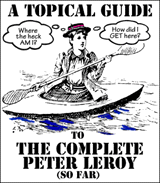
by Mark Dorset
George Steiner on the Case of Fernando Pessoa:
It is rare for a country and a language to acquire four major poets
on one day. This is precisely what occurred in Lisbon on the eighth of
March, 1914. . . .
Looking back on the event (in a letter of 1935),
Pessoa tells of "a trance whose nature I cannot define.... My master had
appeared inside me." Alberto Caeiro wrote thirty-odd poems at commanding
speed. These were followed, "immediately and totally," by six poems by
one Fernando Pessoa. But Caeiro had not sprung into being alone. He had
two principal disciples. One was Ricardo Reis, and then:
Suddenly, in antithesis to the appearance of Ricardo a new individual burst impetuously onto the scene. In one fell swoop, at the typewriter, without hesitation or correction, there appeared the "Triumphal Ode" by Alvaro de Campos—the ode of that name and the man with the name he now has.Pseudonyms, noms de plume, anonymities, and every mode of rhetorical mask are as old as literature. Motives are manifold. They extend from clandestine political writing to pornography, from playful obfuscation to deadly serious personality disorders. The "secret sharer" (Conrad's familiar), the supportive or threatening "double," is a recurrent motif—witness Dostoyevski, Robert Louis Stevenson, and Borges. So is the theme, ancient as the Homeric rhapsode, of poetry "taken under dictation," under the literal and immediate onrush of the Muses, which is to say the voices of the divine or the departed. In that sense of"inspiration," of"being written rather than writing," the techniques of automatic writing far predate Surrealism. A number of major writers have turned utterly against themselves, against their earlier work or style, to the point of seeking its destruction. Multiplicity, the ego made legion, can be festive, as it is in Whitman, or darkly self-ironizing, as it is in Kierkegaard. There are disguises and travesties that the most minute scholarship has never pierced. Simenon was unable to recall either how many novels he had begot or under what early and multiple pseudonyms. In late age, the painter de Chirico stormed through appalled museums and art galleries declaring famous pictures long attributed to him to be fakes. Did he do so because he had grown to dislike them or because he could no longer identify his own hand? As Rimbaud proclaimed, in his instauration of modernity, " 'Je' est un autre": " 'I' is another."
I created, therefore, an inexistent coterie. I sorted out the influences and the relationships, listened, inside myself, to the debates and the difference in criteria, and in all of this, it seemed to me that I, the creator of it all, had the lesser presence. It seemed that it al1 happened independently of me. And it seems to me so sull.
The New Yorker, January 8, 1996
See:
The Passionate Spectator (epigraph): The
spectator is a prince who everywhere rejoices in his incognito.
Reservations Recommended: The
assumed identity, the disguise, is part of the pleasure.
See also:
Appearances
E-mail it to me, Mark Dorset.

 Here
are a couple of swell ideas from Eric Kraft's vivacious publicist, Candi
Lee Manning:
Here
are a couple of swell ideas from Eric Kraft's vivacious publicist, Candi
Lee Manning:
